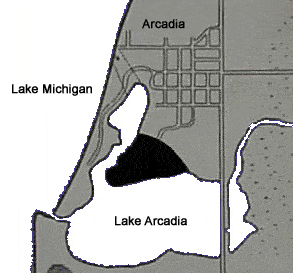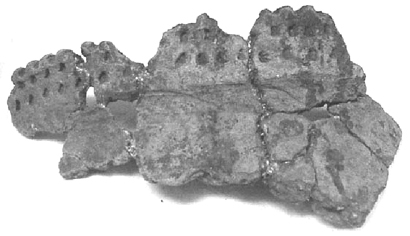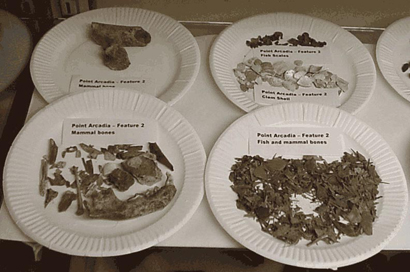Picking Up the Pieces of the Earliest Arcadians
by Ed Howard
Reprinted from Society News, the newsletter of the Arcadia Area Historical Society
June 2009. Volume 15 Issue 1.
|
John Williams long knew that the little point of land protruding into Arcadia Lake from its north shore was a natural spot for early Native American encampments. He’d been finding Indian artifacts there as well as along the natural channel that originally lead into Lake Michigan at the Lake’s northwest end. He surmised that for centuries this could have been a spring to early fall haven for these seasonal inhabitants. The moderated climate (Lake Michigan effect), abundant stone, plant and animal life would have made it ideal for gaining food, fur, tools, and raising corn. |
|
|
But it wasn’t until that day in the early 1980s that John was wakened to the full extent of the habitation. Returning early one evening from his job in Manistee, John, shockingly, noted that heavy machines were clearing the point area. Full-scale excavation for the Point Arcadia subdivision was underway! Running behind and about the earth movers, John desperately began picking up the newly exposed pieces. “It looked like a mound of skulls---but it was pieces of pottery.” John was describing the glaring white objects imbedded in the earthen knoll being banked on the property’s southeastern side. The gathering lasted days, but, when it was over, John Williams had amassed the largest collection of aboriginal artifacts yet to be assembled from the Point Arcadia site. An article in a 1988 issue of the Michigan Archaeologist written by Michael J. Hambacher of the Michigan State Museum recognizes this accomplishment. John, of course, had shared his findings with Mr. Hambacher and other experts on the subject, and an original paper entitled “The Point Arcadia site: Another one bites the dust” was presented at the annual meeting of the Midwest Archaeological Conference, University of Illinois in l988. Though the collection is heavy with pieces from the late Late Woodland period (A.D. 1100/1200 to 1500), a few represent the Middle Woodland period (A.D. 0 to 600), which indicates that life was going on around our little lake long before any of our European ancestors arrived. John has identified four areas of artifact concentration and labeled them Chip, Mica, Pottery; and Corn. The specific location is now bisected by Grebe Street in the Point Arcadia development. The journal article provides maps and photo plates, and a copy is available at the Museum. |
|
|
|
|
|
|
|
|
Though John now lives in Manistee, he has consented to act as our Society expert on local Native American history, artifacts, and sites. The Indian artifacts already on display in the Arcadia Area Historical Museum are from his Point Arcadia collection, as well as from findings he made east of Arcadia along St.Pierre Road. Some of the St. Pierre artifacts are from a more archaic period of Native American culture. John speaks of how the earliest inhabitants probably followed the receding ice north during the end of the last Ice Age---some 11,000 years ago. We are fortunate that John has agreed to be our specialist regarding Native American artifacts. He became a serious student in the field in the early l970s, not long after returning from his stint in Viet Nam as a U.S. Marine. He has participated in many professional archaeological digs and, while enrolled at Triton College in Illinois, even ventured on an anthropological study in South America. His leaders noted his ability to recognize positive sites and his keen eye for spotting the least-exposed of artifacts during the digs. He was asked to lecture, to students and adults, on the subject during his years in Illinois. In spite of an evolving problem with agent orange, John says he is again ready to give talks and share his expertise with young and old alike. |



